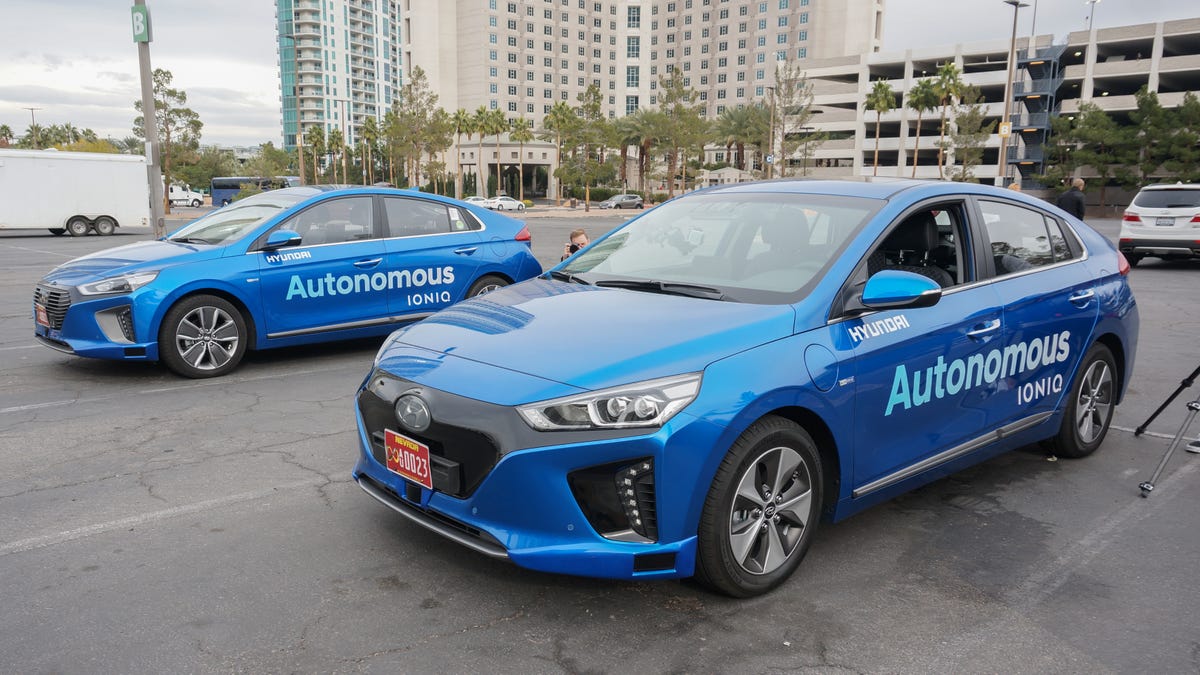Slow, safe and a little boring: Hyundai's self-driving prototype
My only complaint about Hyundai's autonomous Ioniq prototype is that it's a little too careful. Then again, that's definitely a good thing.

Hyundai's electrified Ioniq hasn't even reached dealerships yet and the South Korean automaker is already working to push its technology further, testing a pair of self-driving prototypes in Las Vegas ahead of CES.
From the outside, you'd be hard pressed to tell there's anything special about the Ioniq Electric and Ioniq Hybrid examples waiting for me in a Las Vegas parking lot. The prototypes are designed to look like production cars, so the only external clues that these cars are special are the massive "Autonomous Ioniq" graphics on the vehicles' flanks and three subtle sensor windows in the front bumper.
Nevada issues special autonomous vehicle license plates to automakers testing in the state.
The autonomous Ioniq sees the world through sensors. The aforementioned windows on the front bumper house a trio of LiDAR sensors that look ahead and to the sides of the car to detect objects. Four radar sensors -- long and mid-range sensors aimed ahead and a pair of rear mid-range sensors out back -- work with the lasers to provide 360-degree coverage. There's also a four-camera system looking out from the top of the windshield with two stereoscopic cameras to detect objects and distance, a traffic light phase-detection camera and a Mobileye/TRW camera to detect pedestrians and lane markings.
There are redundancies: The stereo cameras, forward LiDAR and long-range radar all do the same job of detecting objects and sussing out how far ahead they are. However, each technology has its own strengths and weaknesses that makes it useful in different conditions. This means Hyundai's autobot won't be blinded by a bit of fog or a newspaper getting blown over the LiDAR sensor.
High-definition maps and high-accuracy GPS are the last pieces of the autonomous puzzle. The HD maps boast significantly more data than current navigation maps and were developed by Hyundai Motor Group affiliate MnSoft. Data improvements include specific lane data, road grade, curvature and lane width. The autonomous Ioniq prototypes only give you a self-driving option on roads with HD map data and Hyundai is still growing its US map database -- most of the testing and mapping to this point has taken place in Korea -- so my demonstration was stuck to a predetermined course around the Las Vegas Convention Center.
The interior was outfitted with a trio of new displays. The standard Hyundai BlueLink touchscreen is there too, in its usual place in the center of the dashboard. Atop the dash is a new autonomous status display sticking up like bread from a toaster. It shows speed information, a turn list and other autonomous driving info. The prototype also features a pair of hacked-together rear seat monitors showcasing a LiDAR sensor view and the traffic light phase camera's view for demonstration purposes.
This Ioniq boasts a different sort of hands-free system.
I wasn't allowed to sit in the driver's seat for the demo. I was alright with this considering the point is for the car to drive itself. A Hyundai engineer started us off, manually piloting the car out of the parking lot. Once we were on the road, he pushed a button and the computers took over steering, accelerating and braking the car along a predetermined loop.
It was a very slow loop, despite relatively light traffic because the car's behavior is tuned to react very conservatively to stimulus for safety reasons, much more conservative than a human would. If the Ioniq detected a pedestrian stepping into a crosswalk ahead, the car would stop while it watched the human to figure out if it's safe to go. The speed limit was matched and never exceeded. One simple right-hand turn was so ridiculously slow that I began to fear that cars behind us would start honking or cut us off, but none did. I can imagine it would be mildly infuriating to be a human driver stuck behind this overly careful autonomous car.
We didn't need to touch the emergency stop button. The Hyundai always erred on the side of caution.
More importantly, the self-driving Hyundai performed the entire driving loop without any issues. It steered itself around bends and corners, changed lanes, stopped at traffic lights and then pulled away, all without any intervention from the human in the driver's seat until it was time to pull back into the parking lot at the end of the trip. That the most interesting thing about the autonomous Ioniq prototype is how safe and boring it feels is just a bit ironic.
The technology beneath the autonomous Ioniq is exciting enough, I'm OK with the riding experience being a bit slow and boring. A dull trip means the robot got me to my destination safely without drama -- surprises and excitement are the last things I want when handing over control of a car to a computer.
The Ioniq prototype makes a strong first showing for Hyundai's self-driving tech in America and the automaker's post-2020 estimate for bringing an autonomous car to market means that there's plenty of time to refine the tech and pick up the pace.

